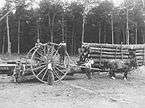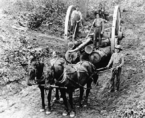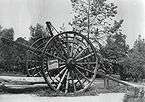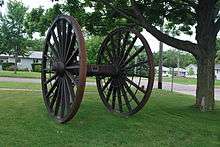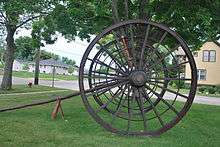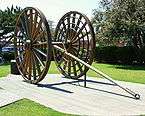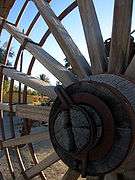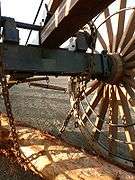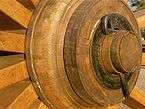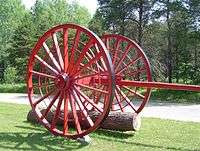
Logs were suspended
from wheel axle

Genuine Overpack logging wheels were always painted red
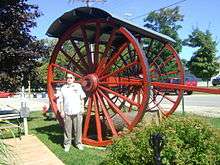
Eleven foot logging wheels
compared to 6 foot person
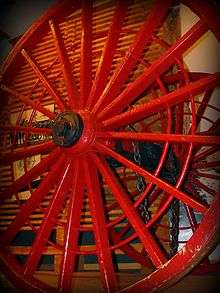
Single logging wheel
Michigan logging wheels,[1] also known as big wheels, high wheels, logging wheels, logger wheels, lumbering wheels, bummer carts, katydids or nibs,[2] are a type of skidder.[3] It extended the season in which the logging industry could extract timber from the North Woods of Michigan, by removing the need for icy ground to travel over. The logging wheels were a specially designed large set of wooden wagon wheels that could carry logs that were up to 100 feet in length, several at a time.
Michigan logging wheels (big wheels) were first built by Silas C. Overpack in 1875, at the request of a farmer who had found they were useful for logging over softer terrain.[4][5] At the time Michigan was the nation's leading producer of lumber.[6][7] He painted his high wheels red.[8]
Usage
Overpack's logging wheels could haul logs without the need for icy ground. They did not sink into mud in the wet terrain of the northern woods where ordinary wagon wheels would get mired in the spring thaw. The wheels also enabled a team of horses to pull several logs at a time. The logs were held by a chain that suspended the logs' weight from the wheel axle, creating a stabilizing, low center of gravity.[9]
Sizes
Overpack sold three sizes of big wheels: 9 feet (2.74 m) high, 9 feet 6 inches (2.90 m) high and 10 feet (3.05 m) high; they cost $100 per diameter foot, a quite considerable investment for the time.[10] Unlike a wagon which carries a load above its axle, these huge wheels carried logs chained beneath the axle. The wheels could carry logs from 12 feet (3.66 m) to 100 feet (30 m) in length and enough logs to total 1,000 to 2,000 board feet of lumber in a single load.[11] The axles were manufactured from hard maple, and the 16-foot tongues were made of ironwood. The wheels were clad with iron rims to protect them from stumps, fallen trees, and rocky terrain. Interior iron rings reinforced the wooden spokes of the wheels. They were pulled by horses, oxen, or tractors.
History
Overpack was a wheelwright in Manistee, Michigan around 1875, when he was approached by a farmer to build a set of 8 feet (2.44 m) wagon wheels. He built these unusually large wagon wheels and sold them to the local farmer. Time passed and later this same farmer returned asking Overpack for an even larger set of wagon wheels. Overpack was very curious by this time. He asked the farmer what he was doing with such large wagon wheels. The farmer replied he was using them to skid logs.[3]
From then on Overpack's big wheels were part of Michigan logging history. Many northern states used them, and Michigan alone had at least 65 different lumber companies that had them.[5] Michigan's rough and wet forest terrain made logging strictly a winter industry in the nineteenth century. The loggers used frozen ground to skid the logs from the woods to the railheads of rails or to river banks for further transporting. In the spring they would slide the logs from the banking grounds into the rivers for the log drive to the sawmills. Overpack made logging possible in all four seasons when he began manufacturing Michigan logging wheels at his Manistee wagon business.[12]
When Overpack exhibited his Michigan logging wheels at the 1893 World's Columbian Exposition in Chicago, they were a sensation and quickly caught on in the forests of the Pacific Northwest. They "received first premium and medal" at this World's Fair.[13] Overpack solicited the support of the Redding Iron Works Company to aid in supplying his product to the western United States. He needed their aid to help overcome shipping issues, which they were able to do with their proximity to the West Coast timber industry.[3] They became then another builder of Overpack's Michigan logging wheels.[14] He then began manufacturing on a large scale and ultimately made thousands of logging wheels.[9] He sold them worldwide and shipped via railroad to other states and Canada.[9] The U.S. Army Forestry Department even took several to France during World War I.[5] They were discontinued by 1930.
Locations containing logging wheels
- Redding, California
- Grayling, Michigan
- Manistee, Michigan
- Ludington, Michigan
- Northern Arizona University
- Historic White Pine Village
- Creston Museum, Creston, BC
- Hartwick Pines Logging Museum[15]
- Camp 5 museum, Laona, Wisconsin
- Michigan History Museum in Lansing
- Red Rock State Park in Sedona, Arizona.
- Riordan Mansion State Historic Park, Flagstaff, AZ
- Empire Area Museum Center, Empire, Michigan
- Paint Creek Cider Mill, Oakland Township, Michigan.
- The Rinelander Logging Museum, Rinelander, Wisconsin
- Manistee County Waterworks Building Historical Museum
- University of Montana College of Forestry and Conservation
Gallery
| Michigan logging wheels examples |
|---|
| Missaukee County, Michigan, c. 1915 |
| Cadillac Big Wheels,
c. 1908 |
| Manistee Michigan museum display |
| Manistee Museum
front lawn |
| Logging wheel display Flagstaff railway station. |
| Slip tongue log skidder Institute of Texan Cultures |
| Logging wheels demonstration |
| Big Wheels, Rinelander, WI |
| Big Wheels, Camp 5, Laona, WI |
|
See also
References
- ↑ The backtracks of high wheel logging by Lorraine Platz
- ↑ Percy W Blandford (1976). Old Farm Tools and Machinery. David & Charles. pp. 153–154. ISBN 0-7153-7151-7.
- 1 2 3 Out of the woods - Big Wheels history
- ↑ Powers, Perry Francis, A History of Northern Michigan and Its People, 1912, p. 707, Lewis Publishing Company, An original at University of Michigan.
- 1 2 3 Moving wood in Michigan by Arvind Badrinarayanan
- ↑ Lumbering in Michigan
- ↑ Background reading - Lumbering in Michigan by Maria Quinlan
- ↑ Logging Big Wheels
- 1 2 3 Kids' education on logging industry
- ↑ Dickmann, Donald, The Forests of Michigan, pp 132-133, University of Michigan Press (2003), ISBN 0-472-06816-4
- ↑ Traverse City in Vintage Postcards By C. S. Wright, page 11
- ↑ Timeline of Wood
- ↑ Cabot, James L., Images of America - Ludington 1830 - 1930, 2005, ISBN 0-7385-3951-1, P. 21
- ↑ Big Wheels Resort
- ↑ Hartwick Pines Logging Museum


